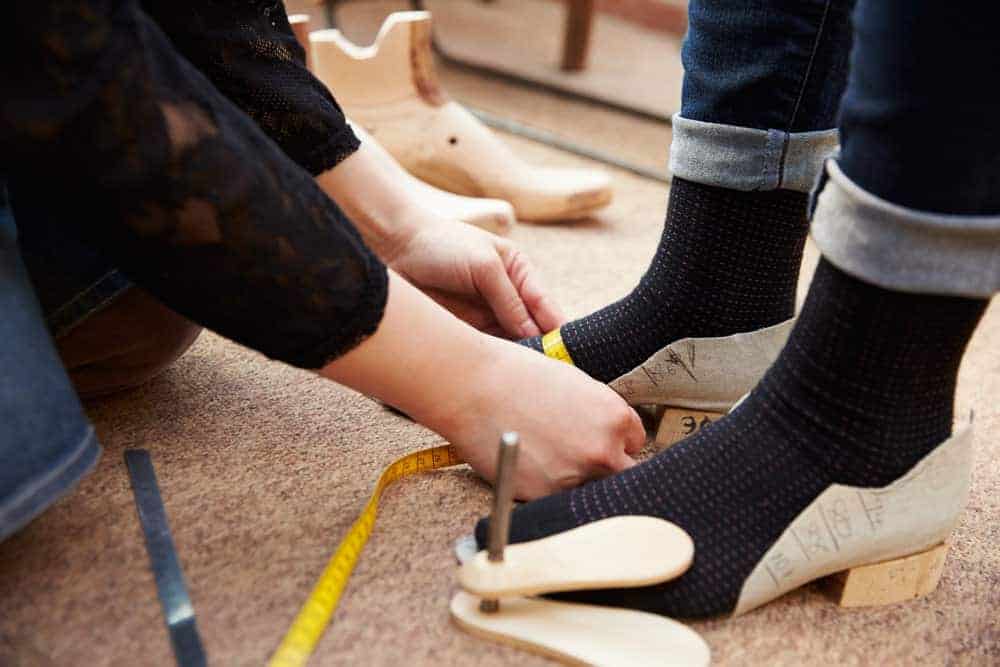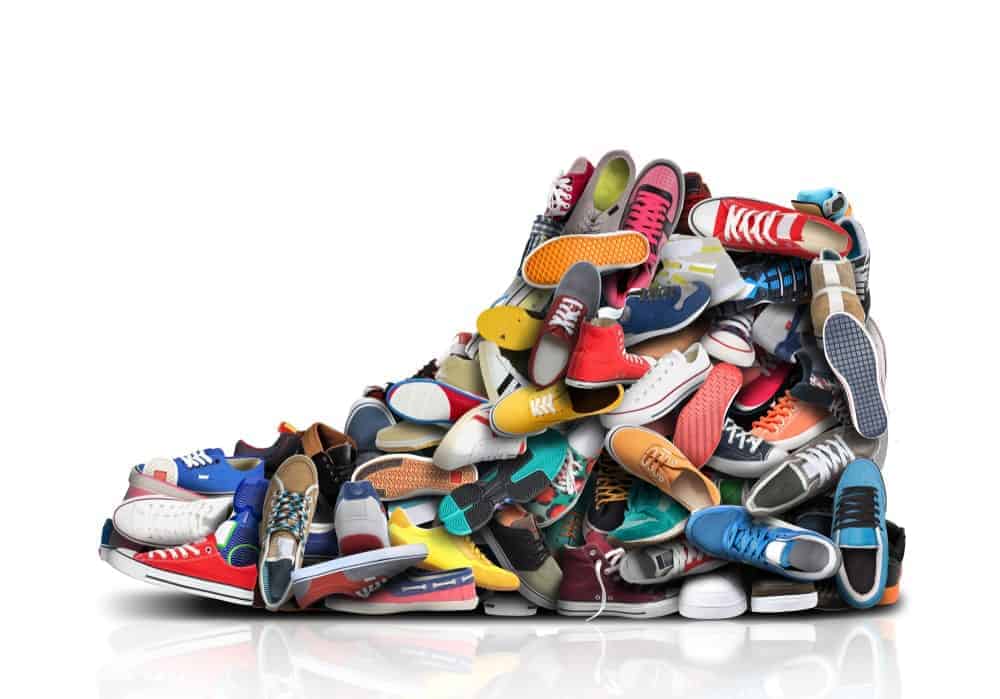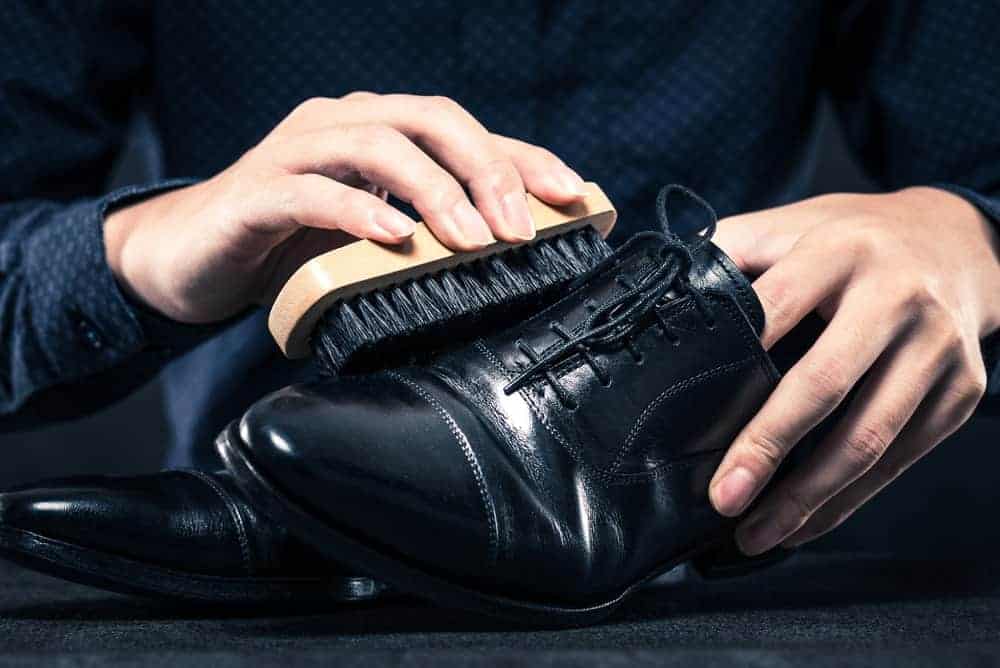Shoe-shopping can be a hassle if you're not sure of your size, especially if you're buying online and can't try the footwear on first. Here's a look at men's, women's and kids' shoe size conversion charts, along with foot-measuring tips, to get your shopping off on the right foot.

While some people enjoy shoe-shopping, for others it can be a chore. This otherwise simple task is a little more complicated when it’s done online. After all, you can’t physically try on the shoes before you pay for them. And some online shoe-sellers won’t accept returns.
So it’s easy to end up stuck with a pair of kicks that, when you put them on, either fall off or pinch your feet to the point of cutting off circulation. Ouch.
So to help you start your shoe-shopping on the right foot, here’s a breakdown of men’s, women’s, and kids’ shoe size conversion charts, as well as how to measure feet to arrive at the right shoe size. But first, let’s step back in time to see how the idea of sizing up one’s feet has evolved over the centuries.
Contents
History of Shoe Sizes
As you might expect, the earliest methods of foot-measuring and shoe sizing were primitive. In many cases, shoemakers did their best to customize footwear to fit the individual. But there were no standard units of measurement. This made for some stressful business transactions, as fights sometimes broke out among merchants or between merchants and customers. And we thought brawls in the marketplace were limited to Black Friday shopping sprees!
The origins of today’s system of foot measurements date all the way back to ancient Rome. Shoemakers used barleycorns to calculate sizes when fashioning sandals. A barleycorn, by the way, is the length of a grain of barley, which is roughly one-third of an inch. I don’t know about you, but learning this little factoid gave me pause to wonder, “Who came up with the idea of using a common ingredient in barley and beer to measure, of all things, feet?”
These early artisans must have been on to something, though, because their system has endured somewhat through the centuries. In 1324, during his reign in England, King Edward II issued a decree making barleycorns the official unit of foot measuring. This was an especially convenient means of accomplishing the task since three barleycorns (usually) equal one inch.
The British monarch certainly left an indelible footprint on the realm of shoemaking and sizing, as that system is, to some extent, still used today in parts of the UK and Ireland. However, this method had its limitations. Barleycorn lengths sometimes varied, and different parts of the UK couldn’t agree on what foot size should be considered “average”.
Much greater strides in foot measuring came in the early 1900s. The first innovation arrived around 1913 and was patented three years later. The Ritz Stick featured a heel stop with a sliding component that could be adjusted at the toes to measure different foot lengths. This invention came to be recognized as the first nationally-recognized means of foot measurement in the United States. Yet it wasn’t until 1988 that the tool was modified for women’s shoe sizing. Manufacturers are still turning out Ritz Sticks today.
The second advance in foot measuring came with the advent of the Brannock device (named after its inventor, Charles Brannock). The device took into account not only a foot’s length, but also its width, converting the measurements to the appropriate shoe size. This allowed for more precise measuring and sizing. Like the Ritz Stick, the Bannock Device can still currently be found, although it’s not an exact replica of the original. Interestingly, half-sizes seem to be an “American” thing, as they could be found in shoe shops in the USA as early as 1887.
A variety of systems exist for measuring feet and calculating shoe sizes. One of the more universally-recognized methods is the Mondopoint System that uses foot length and width in determining the corresponding size. Sizes are based on average foot dimensions, measured in millimeters. Ski boots and military footwear are sized according to this system because it allows for a more precise fit. Definitely a must when you’re performing an hours-long balancing act, as when skiing, or spending hours on your feet, often in rough terrain, as current military service members and veterans know all too well.
Now that you know some of the background about how shoes are sized, let’s take a look at those shoe size conversion charts we mentioned earlier. Most charts compare US, UK, and European size conversions, although others list these numerical scales for other parts of the world, such as Asia and Australia, that have their own systems.
Men’s and Women’s Shoe Chart:

Men’s Shoe Size Conversion Chart
For men and women alike, shoe sizes depend primarily on foot length, but some brands come with additional size variations to accommodate different foot widths. For now, we’ll look at how standard men’s sizes measure up. Here’s a quick rundown of US men’s sizes and the foot lengths they correspond to.
We’ll begin with size 6, which is equivalent to 5.5 in the UK and 39 in much of Europe. These sizes correspond to a foot length of 9¼” or 23.5 cm. For a given men’s size, the UK equivalent is usually a half-size smaller. So if you wear a US men’s size 8, the corresponding UK size would be 7.5. Since some conversion charts only list the foot lengths that go with each size in centimeters, here’s how US sizes pan out in inches for easy reference.
- 6 = 9 1/4″
- 6.5 = 9 1/2″
- 7 = 9 5/8″
- 7.5 = 9 3/4″
- 8 = 9 5/16″
- 8.5 =10 1/8″
- 9 = 10 1/4″
- 9.5 = 10 7/16″
- 10 = 10 9/16″
- 10.5 = 10 3/4″
- 11 = 10 15/16″
- 11.5 = 11 1/8″
- 12 = 11 1/4″
- 12.5 = 11 1/2″
- 13 = 11 9/16
Some brands allow for more precise sizing by factoring in foot width as well. Shoes that accommodate narrow feet will be marked with the appropriate size based on length, followed by the letter B. Medium width is indicated by the letter D. Wide shoes are designated by the size, followed by EE, while extra-wide are denoted by EEEE. Of course, some labels come with only the standard size, or the size followed by a W to indicate “wide.”
Women’s Shoe Size Conversion Charts
For women’s shoes, we’ll start with a size 5. A woman who wears this size has a foot length of 8 9/16″. If she were to buy shoes in the UK, she would be a size 3. So for a given US woman’s shoe size, the corresponding UK size would be two sizes smaller. Many sizing charts you’ll find online come with measurements in centimeters, but this may require a little extra calculation for US shoe-shoppers, since we don’t use the metric system. Here’s a “cheat sheet” of US sizes and their respective lengths in inches for easy reference.
- 5 = 8 9/16″
- 5.5 = 8 3/4″
- 6 = 8 7/8″
- 6.5 = 9 1/16″
- 7 = 9 1/4″
- 7.5 = 9 3/8″
- 8 = 9 1/2″
- 8.5 = 9- 1/16′
- 9 = 9 7/8″
- 9.5 = 10″
- 10 = 10 3/16″
- 10.5 = 10 3/8″
- 11 = 10 1/2″
- 11.5 = 10 11/16″
- 12 = 10 7/8″
As is the case for the guys, some brands also account for foot width in the sizing of women’s shoes. The scale is similar but allows for more variations in width. Narrow shoes are labeled AA and medium width are labeled M or B. A designation of D tells you that the shoe is wide, while footwear marked with an EE are extra-wide.
While men’s and women’s shoe sizes are relatively straightforward, many people are curious about how men’s and women’s shoe sizes actually compare. Generally, there’s a 1.5-size difference between the two. So if a woman wears a women’s size 12.5, that corresponds to a men’s size 11.
Kids’ Shoe Size Conversion Chart

For the most part, children’s sizes are not determined by foot width, although you may occasionally be able to find kids’ shoes or boots for wide feet.
In the US and UK, kids’ shoe sizes start at 0. (Elsewhere in Europe, they start at 15). They run all the way to 13, then start again at 1 for the smaller youth sizes. There are actually a few possible explanations for this, although how this system originated is still a bit of a puzzle. According to one strand of thought, since a 12-inch ruler actually has 13 marks (if you start at 0), then 13 seemed like a good place to end the children’s sizes and then start over with one for adult/youth sizes. Another possibility for the “size 13 mystery” has to do with rudimentary measurement methods. At least a few hundred years ago, many shoemakers held to the idea that a child’s foot was ready for its first shoe when it had reached a length of four inches. They decided that, at puberty, the average kid’s foot had gained another 9 inches of length, hence the number 13. After reaching that length, it was time for adult/youth sizes.
Most charts give you the foot length in centimeters: if you need US shoe size measurements in inches, here’s the list.
- 0 = 3 1/8″
- 1 = 3 1/2″
- 1.5 = 3 5/8″
- 2 = 3 3/4″
- 2.5 = 4″
- 3 = 4 1/8″
- 3.5 = 4 1/4″
- 4 = 4 1/2″
- 4.5 = 4 5/8″
- 5 = 4 3/4″
- 5.5 = 5″
- 6 = 5 1/8″
- 6.5 = 5 1/4″
- 7 = 5 1/2″
- 7.5 = 5 5/8″
- 8 = 5 3/4″
- 8.5 = 6″
- 9 = 6 1/8″
- 9.5 = 6 1/4″
- 10 = 6 1/2″
- 10.5 = 6 5/8″
- 11 = 16 3/4″
- 11.5 = 7″
- 12 = 7 1/8″
- 12.5 = 7 1/4″
- 13 = 7 1/2″
- 13.5 = 7 5/8″
- 1 = 7 3/4″
- 1.5 = 8″
- 2 = 8 1/8″
- 2.5 = 8 1/4″
- 3 = 8 1/2″
- 3.5 = 8 5/8″
- 4= 8 3/4″
- 4.5 = 9″
- 5 = 9 1/8″
- 5.5 = 9 1/4″
- 6 = 9 1/2″
- 6.5 = 9 5/8″
- 7 = 9 3/4″
How to Properly Measure Feet for Shoes

Knowing about shoe sizes will help you make great strides in finding the right fit, but there’s one more step that should not be overlooked: finding your measurements. This will save time when trying on shoes, as you’ll know just what size to look for instead of eyeing a pair that you just have to have, only to discover it’s at least one or two sizes off. And if you’re buying online, you won’t be stuck with the hassle of returning them because they’re the wrong size or, even worse, being forced to keep them because the store doesn’t accept returns. Another good reason to know your measurements: some brands deviate a bit from the norm when it comes to sizing.
To get the most accurate numbers, you will need a tape measure, a pencil, a piece of paper that’s longer than your foot, and possibly some tape. Follow these steps to figure out how long and wide your feet are.
- Place the paper on the floor. If you want to prevent it from sliding around while you measure, go ahead and tape it down.
- Keeping it perpendicular to your piece of parchment, use your pencil to trace all the way around your foot.
- When you’re done, flip the paper over. Trace your other foot on the reverse side.
- Extend your tape measure to measure your foot at its longest (from the heel to the end of your big toe. Then, measure your foot where it is widest. Do this for both feet, and be sure to write the numbers down.
- Keep in mind that the pencil outline gives your foot a little extra “girth.” To get a more accurate idea of your dimensions, subtract 1/4″ (or about 1/2 of a centimeter) from both the length and the width.
To help you really nail your sizing attempts, here are a few more tips.
- Take measurements toward the end of the day, when your feet are likely to be at their biggest. (This is especially important if you’re prone to foot-swelling throughout the day).
- Always measure both feet, as one may be larger than the other. Use the larger of the two to find your size. Otherwise, you’re in for a pinching, painful experience.
- Some people have difficulty balancing while tracing their feet. If this is the case for you, have a friend do the sketching or have something sturdy nearby that you can hang onto if you’re having trouble staying on your feet.
- Last but not least, when measuring, try to wear the kind of socks or tights that you’ll probably wear with your upcoming shoe purchase. That’ll help you better gauge the fit. If you’ve ever bought a pair of shoes without accounting for sock styles and thicknesses, you know how tempting it is to just ditch the restrictive footwear and just go barefoot.
Related conversion charts
We also have a handy women’s clothing size conversion chart and men’s clothing conversion chart.
References:




